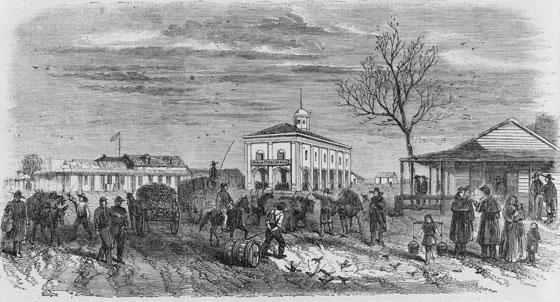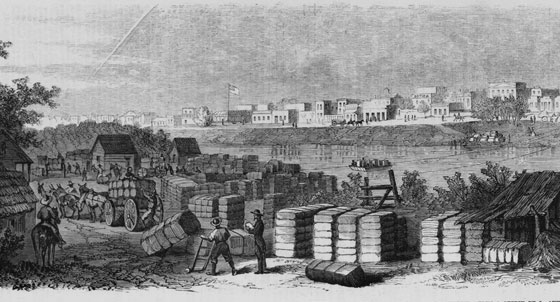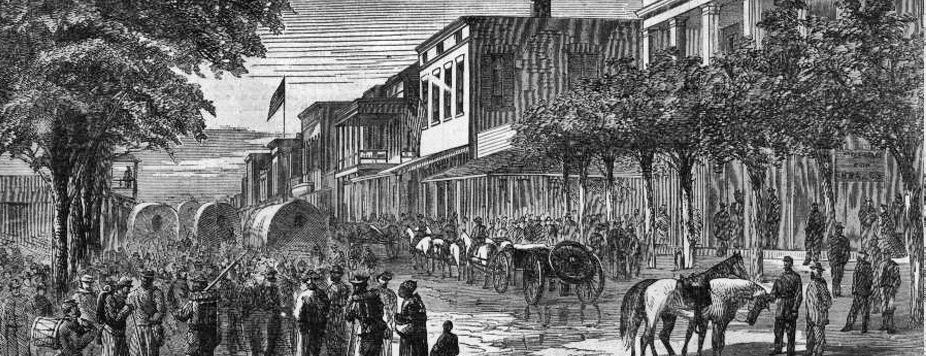Brownsville During the Civil War
Before and during the Civil War, Brownsville was a major hub in the international trade flowing out of the Rio Grande. Slavery was not common in Brownsville, so when the Civil War erupted, Brownsville residents chose sides for either personal or business reasons. When Texas seceded from the Union in February 1861, Confederates chased their Unionist neighbors out of town and confiscated their properties. Many of those Union supporters fled across the river to Matamoros and formed military units to fight their former neighbors. When Union ships blockaded the southern coastline, planters from Louisiana, Arkansas, and Texas shipped their cotton by train to the area south of Houston. From there, the “white gold” as cotton was known, was transferred by wagons on the difficult overland journey to Brownsville, where it could be ferried across the river to Matamoros. Mexico remained a neutral nation, so Union ships could not legally interfere with trade on the Rio Grande or in Mexican ports. By 1862, wagoneers lined up for miles along the road to Brownsville, waiting for their turn to stack their bales on the town’s wharves. Hoping to stop the cotton trade, Union Army General Nathaniel Banks invaded South Texas in 1863. As Banks's troops burned Fort Brown and destroyed cotton cargoes, Unionists returned from Matamoros, reclaimed their property, and this time sent the Confederates rushing to the opposite shore. Military control of the city would change two more times in 1864. In May 1865, the Confederacy surrendered and Union forces, including U.S. Colored Troops, reclaimed Brownsville.
Listen
Antes y después de la Guerra de Secesión estadounidense, Brownsville era un importante punto de confluencia para el comercio internacional que transcurría por el curso del Río Grande. La esclavitud no era un fenómeno poco habitual en Brownsville de manera que, cuando estalló la conflagración, los lugareños tomaron partido por un bando u otro en función de sus motivaciones personales o económicas. Cuando Texas se segregó de la Unión en febrero de 1861, los confederados expulsaron de la localidad a sus vecinos unionistas y confiscaron sus propiedades. Muchos de los partidarios unionistas huyeron al otro lado del río, a Matamoros, y formaron unidades militares para plantar batalla a sus antiguos vecinos. Con el bloqueo naval unionista de la línea costera del sur de los EE.UU., las plantaciones de La Luisiana, de Arkansas y de otras regiones de Texas despachaban por tren los cargamentos de algodón a la región ubicada al sur de Houston, lugar desde el que el «oro blanco», tal como se conocía a dicha mercancía, se transportaba en carros de tiro a través de un difícil viaje terrestre hasta Brownsville, donde podía ser embarcado por el río hasta Matamoros. México se declaró neutral durante el conflicto, de manera que los barcos unionistas no podían interferir de manera legal con el tráfico comercial que discurría por el Río Grande o en los puertos mexicanos. Hacia 1862, los arrieros y sus carruajes formaban filas de varias millas de longitud a la espera de su turno para apilar las balas de algodón en los embarcaderos de la ciudad. Con la esperanza de poner punto final al comercio de algodón, el general unionista del ejército, Nathaniel Banks, invadió el Sur de Texas en 1863. Al incendiar sus tropas el Fuerte Brown y los cargamentos de algodón, los unionistas locales regresaron desde Matamoros y recuperaron sus propiedades, siendo esta vez expulsados los confederados a la ribera opuesta. El control militar de la ciudad cambiaría de manos en dos ocasiones más en 1864. En mayo del año siguiente, la Confederación se rindió y las fuerzas de la Unión, incluyendo el Regimiento Negro de los Estados Unidos, retomó la ciudad de Brownsville.
Escucha
Details
Location:
Market Square Research Center
1150 Market Square
Brownsville, TX 78520
Access:
Tuesday — Friday: By Appointment Only
Saturday — Monday: CLOSED
Contact:
Market Square is open to scholars, students and amateur researchers by appointment. Contact Market Square for more information or to set up an appointment. (Market Square Research Center is currently by appointment only)



